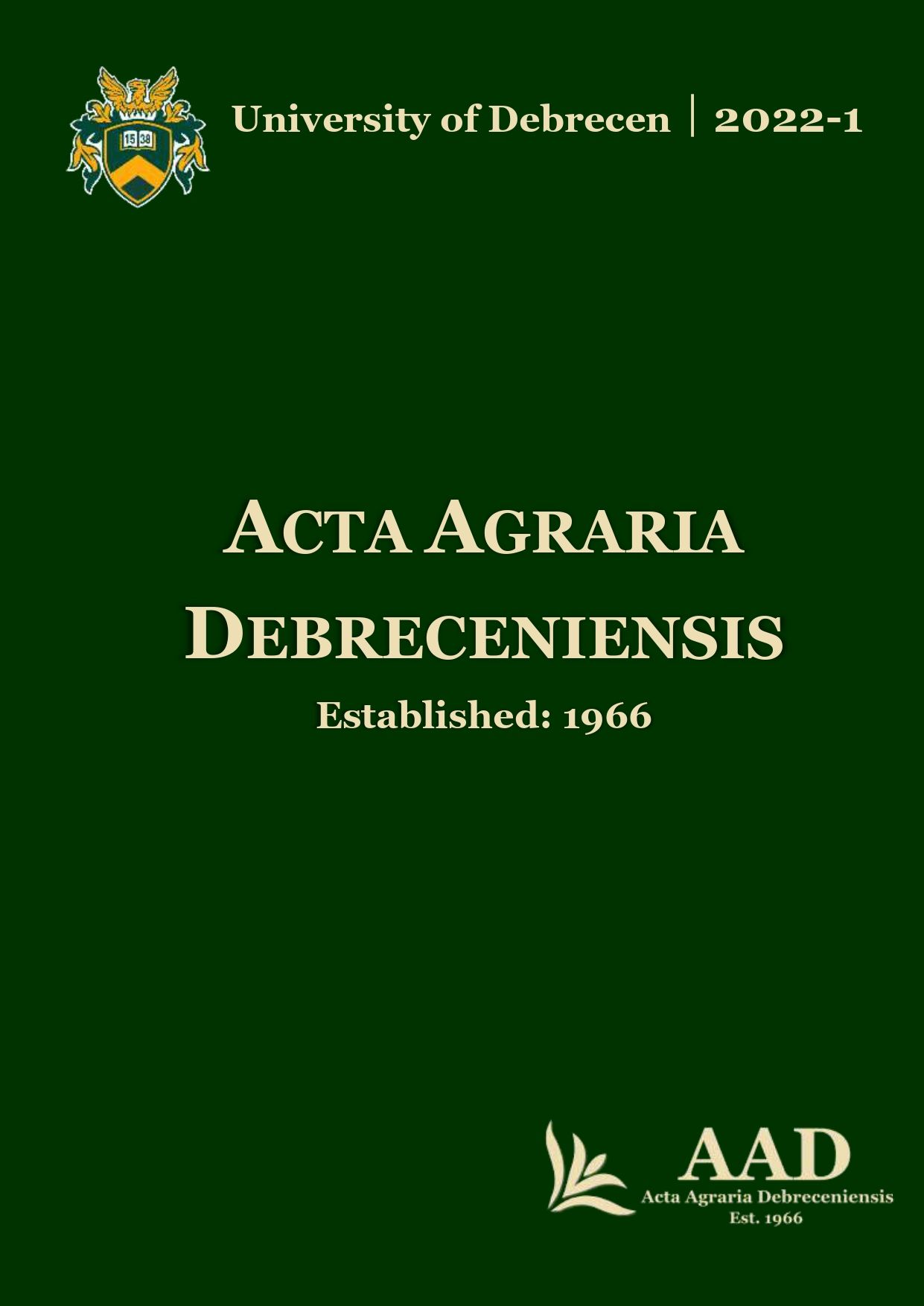Examination of compost maturity using reflectance
Authors
View
Keywords
License
Copyright (c) 2022 by the Author(s)

This work is licensed under a Creative Commons Attribution 4.0 International License.
How To Cite
Accepted 2022-02-23
Published 2022-05-26
Abstract
Composting is one of the most popular recycling processes for organic waste. Composting plays an important role in waste and by-product management and is becoming increasingly important in both sustainable energy management and circular economy. Composting transforms organic matter to produce a safe and stable by-product (compost) that can be applied to arable land in a similar way to fertilizer. Physical, chemical and biological methods can be used to monitor the process and to determine the maturity of the compost, as spectrometric/spectroscopic methods play an important role in the analysis of different environmental samples.
Our aim was to (1) non-destructively detect the effects of different additive ratios on the spectral properties of the composting process and the spectral data of different compost mixtures, (2) to find the wavelength ranges of the reflectance curve (inflection points) sensitive to compost maturity, (3) to determine the correlation between the inflection points and the chemical and physical parameters measured in compost by conventional methods.
The mixture of broiler and hen manure and zeolite was composted 62 days in windrow composting. In the composting experiment, the moisture content and temperature (°C) were measured every three days and compost samples were taken and in 10% destillated aquaeous suspension were measured the pH and electrical conductivity (mS cm-1). Compost samples dried to mass stability were spectrally analyzed in the wavelength range 400–1000 nm with AvaSpec 2048 spectrometer.
Based on the results, the reflectance of mature compost were smaller in the last days of composting than the reflectance values of day 0 samples, thus compost maturity can be detected spectral in the VIS-NIR wavelength range. For the tested compost prisms, the reflectance of each sampling day shows a constant slope, with a significant overlap of the reflectance curves up to 400–700 nm wavelength range, and there was a breakpoint in the 700–750 nm wavelength range which was proved by binary encoding.
References
- Albrecht, R.–Joffre, R. - Gros, R.–Le Petit, J.–Terrom, G.–Périssol, C. (2008): Efficiency of near-infrared reflectance spectroscopy to assess and predict the stage of transformation of organic matter in the composting process. Bioresource Technology, 99(2), 448–455.
- Bernal, M.P.–Paredes, C.–Sanchez-Monedero, M.A.–Cegarra, J. (1998): Maturity and stability parameters of composts prepared with a wide range of organic wastes. Bioresource Technology. 63, 91–99.
- Bonifazi, G.–Serranti, S. (2008): Compost quality control by hyprespectral imaging. Proceedings of SPIE – The International Society for Optical Engineering. 7003.
- Bökfi, K.–Nagy, A.–Riczu, P.–Gyug, N.–Petis, M.–Blaskó, L.–Tamás, J. (2016): Húsliszt és hemoglobin vértermék jellemzőinek nem invazív módszerekkel történő értékelése a VIS-NIR hullámhossz tartományban. Agrártudományi közlemények, 2016/69.
- Buiten, H.J. (1993): General Aspects of Imaging and Recording of Remote Sensing Data. In: Buiten, H.J.–Cleves, J.G.P.W. (Eds) (1993): Land observation by remote sensing – Theory and Applications, Overseas Publishers Association, Amsterdam, 63–82.
- Chen, Y.–Imbar, Y. (1993): Chemical and spectroscopic analysis of organic matter transformation during composting in relation to compost maturity In: Hoitink, H.A.J.–Keener H.M. (Eds.): Science and Engineering of Composting, The Ohio State University, pp. 551–600.
- Clark, R.N. (1999): Spectroscopy of rocks and minerals and principles of spectroscopy. John Wiley & Sons, Chichester, UK. 3–58.
- Castaldi, G.–Alberti, R.–Merella, P.M. (2005): Study of the organic matter evolution during municipal solid waste composting aimed at identifying suitable parameters for the evaluation of compost maturity. Waste Management, 25, pp. 209–213.
- Fujiwara, T.–Murakami, K. (2007): Application of near infrared spectroscopy for estimating available nitrogen in poultry manure compost. Soil Science and Nutrition 53:102–107.
- Galvez-Sola, L.–Moral, R.–Moreno-Caselles, J.–Perez-Murcia, M.D.–Perez-Espinosa, A.–Bustamante, M.A.–Said-Pullicino, D.–Paredes, C. (2010): Evaluation of the Effectiveness of near Infrared Reflectance Spectroscopy (NIRS) on Fe, Cu, Mn and Zn Estimation in Compost. In: Li, S.–Wang, Y.–Cao, F.–Huang, P.–Zhang, Y. (eds.) (2010): Progress in Environmental Science and Technology (Vol. II.) Part A. Proceedings of the 2009 International Symposium on Environmental Science and Technology. itavaara
- Haug, R.T. (1993): The Practical Handbook of Compost Engineering. Lewis Publishers, Boca, Raton, FL.
- Huang, G.– Han, I.–Yang, Z.–Wang, X. (2008): Evaluation of the nutrient metal content in Chinese animal manure compost using near infrared spectroscopy (NIRS). Bioresource Technology 99:8164-8169.
- Itavaara, M.–Venelampi, O.–Vikman, M.–Kapanen, A. (2002): Compost Maturity – Problems Associated with Testing. In: Insam, H.– Riddech, N.–Klammer S. (eds.) (2002) Microbiology of Composting. Springer, Berlin, Heidelberg.
- Kovács, D.–Füleky, Gy. (2016): A komposztérettség meghatározásának módszerei – szemle. Agrokémia és talajtan. 65:135–160.
- Malley, D.F.–McClure, C.–Martin, P.D.–Buckley, K.–McCaughey, W.P. (2005): Compositional analysis of cattle manure during composting using a field-portable near-infrared spectrometer. Communications in Soil Science and Plan Analysis. 36:455–475.
- Mazer, A.S.–Martin, M.–Lee, M.–Solomon, J.E. (1988): Image processing software for imaging spectrometry data analysis, Remote Sensing of Environment, 24:201–210.
- Mortimore, J.L.–Marshall, L.J.R.–Almond, M.J.–Hollins, P.–Matthews, W. (1984): Analysis of red and yellow ochre samples from Clearwell Caves and Catalhoyuk by vibrational spectroscopy and other techniques. Spectrochimica Acta Part A: Molecular and Biomolecular Spectroscopy. 60, 1179–1188.
- Nagy, A.–Fórián, T.–Tamás, J. (2012): Fejlett környezetállapot-értékelési eszközök alkalmazása gyümölcskultúrákban. Agrártudományi Közlemények 49:221–225.
- R Core Team (2017): R: A language and environment for statistical computing. R Foundation for Statistical Computing, Vienna, Austria. URL https://www.R-project.org/.
- Riczu, P. (2015): Spektrális információk alkalmazása a precíziós gyümölcstermesztésben. Kerpely Kálmán Doktori Iskola. Doktori Disszertáció. 144 p.
- Tang, J.C.–Maie, N.–Tada, Y.–Katayama, A. (2006): Characterization of the maturing process of cattle manure compost. Process Biochemistry. 41: 380–389.
- Tiquia, S.M. (2005): Microbiological parameters as indicators of compost maturity. Journal of Applied Microbiology 99:816–828.
- Wang, P.–Changa, C.M.–Watson, M.E.–Dick, W.A.–Chen Y.–Hointink, H.A.J. (2004): Maturity indices for composted dairy and pig manures. Soil Biology and Biochemistry. 36:767–776.

 https://doi.org/10.34101/actaagrar/1/10320
https://doi.org/10.34101/actaagrar/1/10320